Tutorial: 1D ADE transport simulation
Demo of 1D transport equation
Contents
Problem definition
The domain of the problem will be 5 km long.
L = 5000;
We will discretize the domain into 50 m linear line elements. Therefore the coordinates of the points are
p = ( 0:50:L )'; Np = size(p, 1);
Next we define the 1D mesh. To generate a uniform 1D mesh we do not need any special software, however we need to create a structure variable, to hold the mesh information, similar to the one we use in more complex meshes. The first 2 lines of code are not used and descibe the 0 dimension elements e.g. boundary points. (You could set MSH(1,1) = []; instead)
MSH(1,1).elem(1,1).type = 'Bndpnt'; MSH(1,1).elem(1,1).id = [1;Np]; MSH(2,1).elem(1,1).type = 'line'; MSH(2,1).elem(1,1).id = [(1:Np-1)' (2:Np)']; Nel = size(MSH(2,1).elem(1,1).id,1);
For initial conditions we will use a constant concentration of of 50 mg/L at the first node with id 1
CC = [1 50];
The initial distribution of the concentration will be zero
Cinit = zeros(Np, 1);
and we will run the simulation for 150 years with yearly step
T = (0:150)'*365;
Since we do not have any water flows we set a vector of zeros
F = sparse(Np,1);
and we will use crank Niclolson scheme
wmega = 0.5;
Last we will define the few simulation options
opt.dim=1; % This is the dimension of the problem opt.el_type='line'; %the element type opt.el_order='linear';% the element order (linear is the only valid option) opt.assemblemode='vect';% theis is the mode. (use always vectorized option) opt.capacmode='consistent';% option regarding the capacitance matrix (other option is 'lumped')
Constant transport parameters, no decay, no retardation
First we will illustrate the most simple transport case with all transport properties constant. In addition we will assume no retardation and decay
aL = 500; %[m] longitudinal dispersivity v = 0.15; %[m/day] velocity lambda = 0; %[1/day] radioactive decay K_d = 0; %[m^3/Kg] equilibrium distribution coefficient rho_b = 1;% bulk density Dm = 1.1578e-004;%[m^2/day] Molecular diffusion coefficient theta = ones(Nel,1);
To assemble the mass and dispersivity matrix we call the function
[Dglo Mglo c]= Assemble_LHS_std(p, MSH(2,1).elem(1,1).id,...
aL, v, rho_b, K_d, lambda, theta, Dm, CC, opt);
... and we are ready to solve the transport equation
C1 = SteadyFlowTransport(Mglo, Dglo, F, Cinit, T, c, wmega);
Plotting concentration profiles and the breakthrough curve at the outlet in matlab is easy
figure('Position',[100 100 660 220]) subplot(1,2,1); surf(p/1000,T(2:end)/365,C1,'edgecolor','none') view(0,90) axis([0 5 0 150]) xlabel('Distance [km]') ylabel('Time [years]') colorbar subplot(1,2,2) plot(T(2:end)/365,C1(:,end)) xlabel('Time [years]') ylabel('Concentration at the outlet [mg/L]')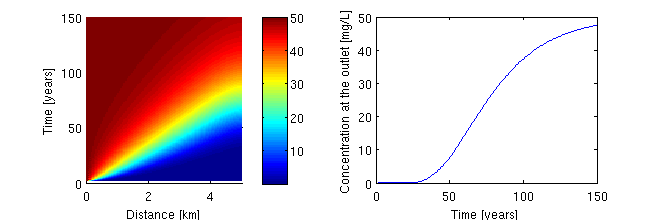
Constant transport parameters, with decay and retardation
Now lets examine the effect of the radioactive decay on the previous problem. lambda is defined as ln(2)/half-life. We will iterate through various lambda coefficients which correspond to different half-life times.
half_life = [10:10:100]*365; lambda = log(2)./half_life; clear lgnd lgnd{1,1} = 'no decay'; for i = 1:length(lambda) [Dglo Mglo c]= Assemble_LHS_std(p, MSH(2,1).elem(1,1).id,... aL, v, rho_b, K_d, lambda(i), theta, Dm, CC, opt); c_temp = SteadyFlowTransport(Mglo, Dglo, F, Cinit, T, c, wmega); C_l(:,i) = c_temp(:,end); lgnd{i+1,1} = [num2str(half_life(i)/365) ' yr half-life']; end figure('Position',[100 100 560 420]) plot(T(2:end)/365,C1(:,end),'--r') hold on plot(T(2:end)/365,C_l) xlabel('Time [years]') ylabel('Concentration at the outlet [mg/L]') title('Decay effect') legend(lgnd,'Location','NorthWest') hold off
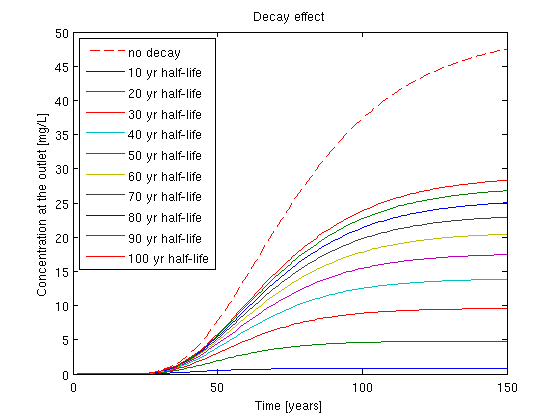
Next we will set the the decay equal to zero and solve for various retardation values
lambda = 0; K_d = [0.5:0.5:4]; clear lgnd lgnd{1,1} = 'R = 1'; for i = 1:length(K_d) [Dglo Mglo c]= Assemble_LHS_std(p, MSH(2,1).elem(1,1).id,... aL, v, rho_b, K_d(i), lambda, theta, Dm, CC, opt); c_temp = SteadyFlowTransport(Mglo, Dglo, F, Cinit, T, c, wmega); C_r(:,i) = c_temp(:,end); lgnd{i+1,1} = ['R = ' num2str(1+K_d(i))]; end clf plot(T(2:end)/365,C1(:,end),'--r') hold on plot(T(2:end)/365,C_r) xlabel('Time [years]') ylabel('Concentration at the outlet [mg/L]') title('Retardation effect') legend(lgnd,'Location','NorthWest')
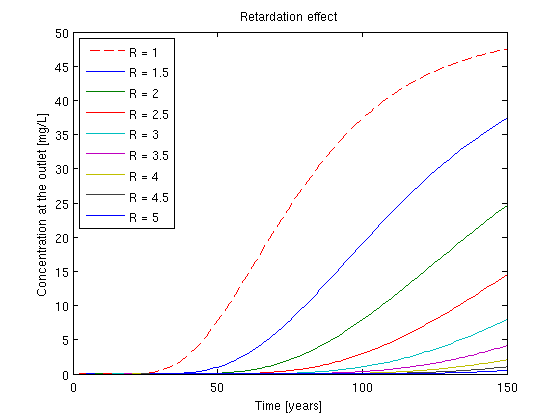
Variable transport parameters
Last we will see how to use variable parameters. Let the velocity be a function of x as follows:
V_fnc = inline('0.5*exp(-((x-2500)/500).^2)+0.15');
The velocity profile along the domain is defined as
V_nd = V_fnc(p);
figure('Position',[100 100 300 300])
plot(p, V_fnc(p));
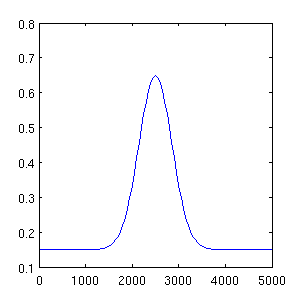
We solve this by simply passing the velocity matrix as agrument
K_d = 0; [Dglo Mglo c]= Assemble_LHS_std(p, MSH(2,1).elem(1,1).id,... aL, V_fnc(p), rho_b, K_d, lambda, theta, Dm, CC, opt); C_v = SteadyFlowTransport(Mglo, Dglo, F, Cinit, T, c, wmega); figure('Position',[100 100 560 420]) subplot(2,2,1); surf(p/1000,T(2:end)/365,C1,'edgecolor','none') view(0,90) axis([0 5 0 150]) xlabel('Distance [km]') ylabel('Time [years]') title('Constant parameters') colorbar subplot(2,2,2); surf(p/1000,T(2:end)/365,C_v,'edgecolor','none') view(0,90) axis([0 5 0 150]) xlabel('Distance [km]') ylabel('Time [years]') title('Variable Velocity') colorbar subplot(2,2,3); plot(T(2:end)/365,C1(:,end)) xlabel('Time [years]') ylabel('Concentration at the outlet [mg/L]') axis([0 150 0 50]) subplot(2,2,4); plot(T(2:end)/365,C_v(:,end)) xlabel('Time [years]') ylabel('Concetration at the outlet [mg/L]') axis([0 150 0 50])
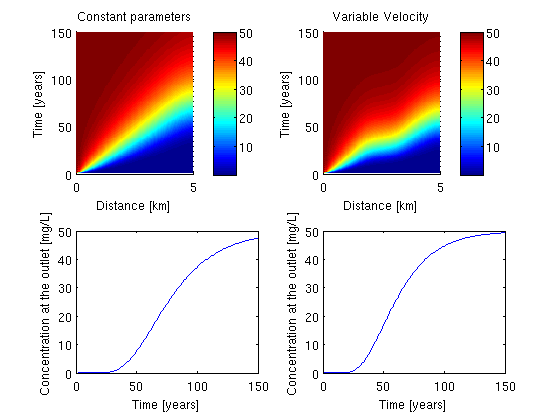
Now lets define some other transport properties as function of x. Note that typically these do not make sence in real cases.
The longitudinal dispersivity will be a linear function of x which varies from 200 m at the inlet to 5000 m at the outlet.
aL_fnc = inline('200+x*0.96');
We solve this in similar way
[Dglo Mglo c]= Assemble_LHS_std(p, MSH(2,1).elem(1,1).id,...
aL_fnc(p), V_fnc(p), rho_b, K_d, lambda, theta, Dm, CC, opt);
C_aL = SteadyFlowTransport(Mglo, Dglo, F, Cinit, T, c, wmega);
Now lets define a variable decay constant. We assume that the decay is zero for the first half of the domain and then the decay constant corresponds to 30 years half-life.
lmd_fnc = inline('(x>2500)*log(2)/(30*365)'); [Dglo Mglo c]= Assemble_LHS_std(p, MSH(2,1).elem(1,1).id,... aL_fnc(p), V_fnc(p), rho_b, K_d, lmd_fnc(p), theta, Dm, CC, opt); C_lmd = SteadyFlowTransport(Mglo, Dglo, F, Cinit, T, c, wmega); figure('Position',[100 100 560 420]) subplot(2,2,1); surf(p/1000,T(2:end)/365,C_aL,'edgecolor','none') view(0,90) axis([0 5 0 150]) xlabel('Distance [km]') ylabel('Time [years]') title('... and Variable Dispersivity') colorbar subplot(2,2,2); surf(p/1000,T(2:end)/365,C_lmd,'edgecolor','none') view(0,90) axis([0 5 0 150]) xlabel('Distance [km]') ylabel('Time [years]') title('... and Variable Decay') colorbar subplot(2,2,3); plot(T(2:end)/365,C_aL(:,end)) xlabel('Time [years]') ylabel('Concentration at the outlet [mg/L]') axis([0 150 0 50]) subplot(2,2,4); plot(T(2:end)/365,C_lmd(:,end)) xlabel('Time [years]') ylabel('Concentration at the outlet [mg/L]') axis([0 150 0 50])
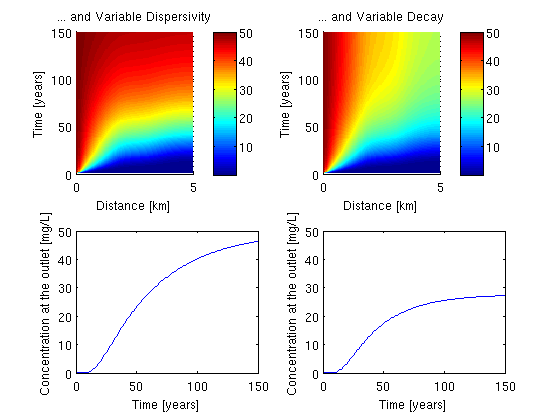
Note that the code to solve the transport is just few lines. The majority of the code above is about plotting

